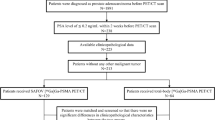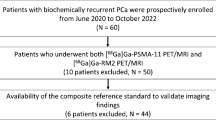Abstract
Purpose
The purpose of this study was to assess whether total-body [68 Ga]Ga-PSMA-11 PET/CT could improve the detection rate compared with conventional [68 Ga]Ga-PSMA-11 PET/CT in patients with biochemical recurrent prostate cancer.
Methods
Two hundred biochemical recurrent prostate cancer patients with similar clinicopathological characteristics were included, of whom 100 patients underwent early total-body [68 Ga]Ga-PSMA-11 PET/CT and diuretic-delayed total-body [68 Ga]Ga-PSMA-11 PET/CT, and the other 100 patients received early conventional [68 Ga]Ga-PSMA-11 PET/CT and diuretic-delayed conventional [68 Ga]Ga-PSMA-11 PET/CT. The detection rates of total-body [68 Ga]Ga-PSMA-11 PET/CT and conventional [68 Ga]Ga-PSMA-11 PET/CT were compared using a chi-square test and stratified analysis. The image quality of total-body [68 Ga]Ga-PSMA PET/CT and conventional [68 Ga]Ga-PSMA-11 PET/CT was compared based on subjective scoring and objective parameters. Subjective scoring was conducted from background noise and lesion prominence using a 5-point scale. Objective parameters were evaluated by SUVmax, SUVmean, the standard deviation (SD) of SUV, and the signal-to-noise ratio (SNR) of liver and gluteus maximus. The SUVmax of the recurrent lesions was also measured.
Results
The liver SD of the total-body [68 Ga]Ga-PSMA-11 PET/CT was significantly lower than that of conventional [68 Ga]Ga-PSMA-11 PET/CT, the SNR was significantly higher than that of conventional [68 Ga]Ga-PSMA-11 PET/CT, and the subjective evaluation was significantly better than that of conventional [68 Ga]Ga-PSMA-11 PET/CT. The detection rate of total-body [68 Ga]Ga-PSMA PET/CT for biochemical recurrence of prostate cancer was significantly higher than that of conventional [68 Ga]Ga-PSMA-11 PET/CT (91.0% vs. 74.0%, P = 0.003). Total-body [68 Ga]Ga-PSMA-11 PET/CT had better detection efficiency for patients with a Gleason score ≤ 8 or PSA ≤ 2 ng/ml. The advantages of diuretic-delayed total-body [68 Ga]Ga-PSMA-11 PET/CT were more obvious.
Conclusion
Total-body [68 Ga]Ga-PSMA-11 PET/CT could significantly improve the detection rate compared with conventional [68 Ga]Ga-PSMA-11 PET/CT in patients with biochemical recurrent prostate cancer.





Similar content being viewed by others
Data availability
The data could be obtained from the corresponding author upon request.
References
Siegel RL, Miller KD, Fuchs HE, Jemal A. Cancer statistics, 2022. CA Cancer J Clin. 2022;72(1):7–33.
Isbarn H, Wanner M, Salomon G, Steuber T, Schlomm T, Kollermann J. Long-term data on the survival of patients with prostate cancer treated with radical prostatectomy in the prostate-specific antigen era. BJU Int. 2010;106(1):37–43.
Huo H, Shen S, He D, Liu B, Yang F. Head-to-head comparison of 68Ga-PSMA-11 PET/CT and 68Ga-PSMA-11 PET/MRI in the detection of biochemical recurrence of prostate cancer: summary of head-to-head comparison studies. Prostate Cancer Prostatic Dis. 2023;26(1):16–24.
Zhang X, Cherry SR, Xie Z, Shi H, Badawi RD, Qi J. Subsecond total-body imaging using ultrasensitive positron emission tomography. Proc Natl Acad Sci U S A. 2020;117(5):2265–7.
Badawi RD, Shi H, Hu P, et al. First human imaging studies with the EXPLORER total-body PET scanner. J Nucl Med. 2019;60(3):299–303.
Zhang X, Xie Z, Berg E, et al. Total-body dynamic reconstruction and parametric imaging on the uEXPLORER. J Nucl Med. 2020;61(2):285–91.
Cherry SR, Jones T, Karp JS, Qi J, Moses WW, Badawi RD. Total-body PET: maximizing sensitivity to create new opportunities for clinical research and patient care. J Nucl Med. 2018;59(1):3–12.
Zhang X, Zhou J, Cherry SR, Badawi RD, Qi J. Quantitative image reconstruction for total-body PET imaging using the 2-meter long EXPLORER scanner. Phys Med Biol. 2017;62(6):2465–85.
Tan H, Sui X, Yin H, et al. Total-body PET/CT using half-dose FDG and compared with conventional PET/CT using full-dose FDG in lung cancer. Eur J Nucl Med Mol Imaging. 2021;48(6):1966–75.
Zhao YM, Li YH, Chen T, et al. Image quality and lesion detectability in low-dose pediatric 18F-FDG scans using total-body PET/CT. Eur J Nucl Med Mol Imaging. 2021;48(11):3378–85.
Zhang YQ, Hu PC, Wu RZ, et al. The image quality, lesion detectability, and acquisition time of 18F-FDG total-body PET/CT in oncological patients. Eur J Nucl Med Mol Imaging. 2020;47(11):2507–15.
Fu F, Li X, Wu Y, et al. Total-body dynamic PET/CT of micro-metastatic lymph node in a patient with lung cancer. Eur J Nucl Med Mol Imaging. 2021;48(5):1678–9.
Eiber M, Herrmann K, Calais J, et al. Prostate cancer molecular imaging standardized evaluation (PROMISE): proposed miTNM classification for the interpretation of PSMA-ligand PET/CT. J Nucl Med. 2018;59(3):469–78.
van Sluis J, Boellaard R, Somasundaram A, et al. Image quality and semiquantitative measurements on the biograph vision PET/CT system: initial experiences and comparison with the biograph mCT. J Nucl Med. 2020;61(1):129–35.
Chen W, Liu L, Li Y, et al. Evaluation of pediatric malignancies using total-body PET/CT with half-dose [18F]-FDG. Eur J Nucl Med Mol Imaging. 2022;49(12):4145–55.
Van den Broeck T, van den Bergh RCN, Briers E, et al. Biochemical recurrence in prostate cancer: the European Association of Urology Prostate Cancer Guidelines Panel Recommendations. Eur Urol Focus. 2020;6(2):231–4.
Fendler WP, Eiber M, Beheshti M et al. PSMA PET/CT: joint EANM procedure guideline/SNMMI procedure standard for prostate cancer imaging 2.0. Eur J Nucl Med Mol Imaging. 2023;50(5):1466–1486.
Hohberg M, Kobe C, Täger P, et al. Combined early and late 68Ga-PSMA-HBED-CC PET scans improve lesion detectability in biochemical recurrence of prostate cancer with low PSA levels. Mol Imaging Biol. 2019;21:558–66.
Alberts I, Sachpekidis C, Gourni E, et al. Dynamic patterns of 68Ga-PSMA-11 uptake in recurrent prostate cancer lesions. Eur J Nucl Med Mol Imaging. 2020;47(1):160–7.
Alberts I, Niklas-Hünermund J, Sachpekidis C, et al. Combination of forced diuresis with additional late imaging in 68Ga-PSMA-11 PET/CT: effects on lesion visibility and radiotracer uptake. J Nucl Med. 2021;62(9):1252–7.
Kunikowska J, Pełka K, Tayara O, Królicki L. 68Ga-PSMA-11 PET/CT in patients with biochemical recurrence of prostate cancer after primary treatment with curative intent-impact of delayed imaging. J Clin Med. 2022;11(12):3311.
Rouvière O, Vitry T, Lyonnet D. Imaging of prostate cancer local recurrences: why and how? Eur Radiol. 2010;20:1254–66.
Daub Witherspoon ME, Pantel AR, Pryma DA, Karp JS. Total-body PET: a new paradigm for molecular imaging. Br J Radiol. 2022;95(1140):20220357.
Funding
This study was supported by the National Key R&D Program of China (No. 2021YFA0910004); National Natural Science Foundation of China (No. 82171972); Clinical Research Project of Health Industry of Shanghai Municipal Health Commission (20214Y0438); and Nurture Projects for the Youth Medical Talents-Medical Imaging Practitioners Program (SHWRS(2021)_099).
Author information
Authors and Affiliations
Corresponding authors
Ethics declarations
Ethical approval
The study involving human participants was in line with the principles of the ethics committee in Renji Hospital and the declaration of Helsinki in 1964. Animal-based research was not included in this study.
Consent to participate
Informed consent was obtained from all patients.
Consent for publication
Not applicable.
Conflict of interest
The authors declare no competing interests.
Additional information
Publisher's note
Springer Nature remains neutral with regard to jurisdictional claims in published maps and institutional affiliations.
Yining Wang and Zijun Chen are co-first authors and contributed equally to this manuscript.
Ruohua Chen and Jianjun Liu are co-corresponding authors and contributed equally to this manuscript.
Rights and permissions
Springer Nature or its licensor (e.g. a society or other partner) holds exclusive rights to this article under a publishing agreement with the author(s) or other rightsholder(s); author self-archiving of the accepted manuscript version of this article is solely governed by the terms of such publishing agreement and applicable law.
About this article
Cite this article
Wang, Y., Chen, Z., Zhu, Y. et al. Total-body [68 Ga]Ga-PSMA-11 PET/CT improves detection rate compared with conventional [68 Ga]Ga-PSMA-11 PET/CT in patients with biochemical recurrent prostate cancer. Eur J Nucl Med Mol Imaging 50, 4096–4106 (2023). https://doi.org/10.1007/s00259-023-06355-5
Received:
Accepted:
Published:
Issue Date:
DOI: https://doi.org/10.1007/s00259-023-06355-5




